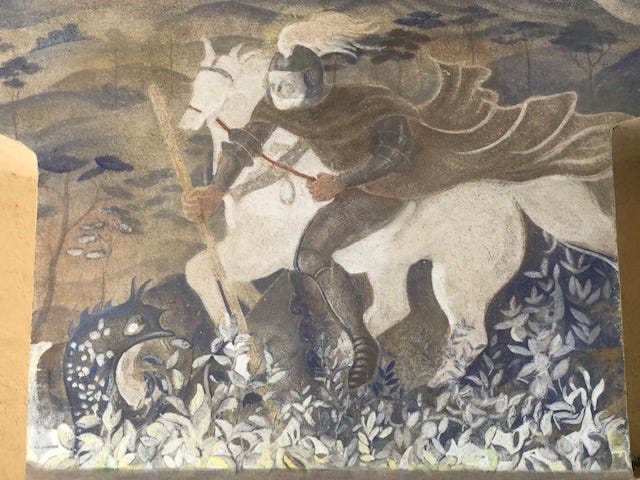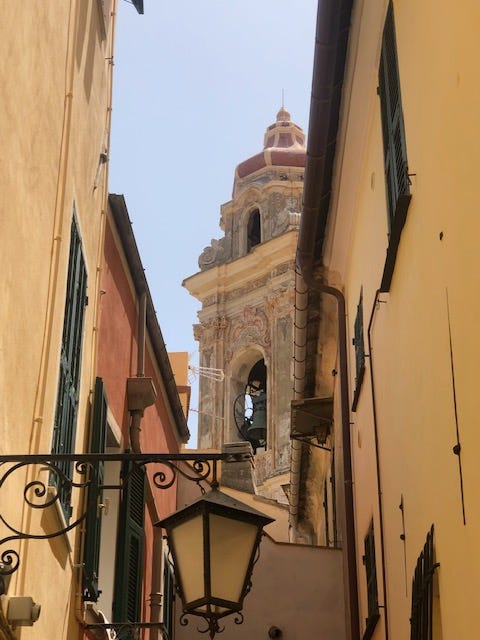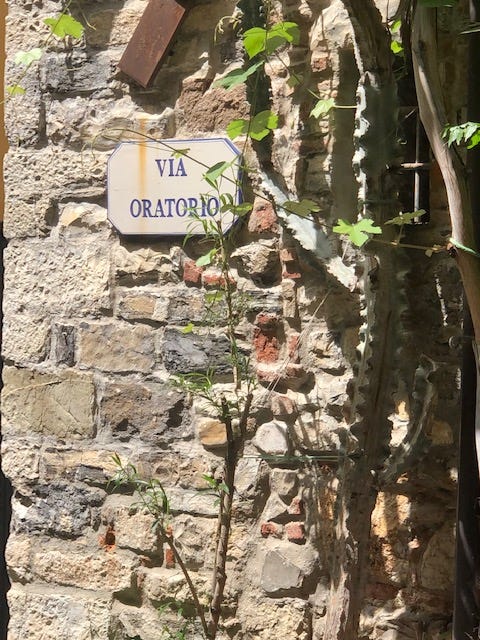💚🤍❤️ CERVO
Surrounded by olive groves, vineyards, and terraces where the scents of basil, rosemary, and salvia meet with a breathtaking view of the Mediterraneo, you find the beautiful medieval village of CERVO!
The Golfo Dianese is the natural basin of the Ligurian Sea, between the Capo Mele in the East and the Capo Berta in the West. Together with the Capo Cervo, these three form I Tre Capi that must be overcome during the famous cycling race Milano - San Remo. Because of its special location on the promontory, this borgo is built circularly upwards. Cervo, with its pastel-coloured houses, walled by ramparts and towers, is a relic of the Middle Ages, when it had to defend itself against Saracen pirates and looters. Four round-arched entrance gates are still present: Porta Santa Caterina, Canarda, Marina en Bondai.
When we enter the village through the Bondai gate, we are immediately surprised by a mural to the left of Saint George and the dragon, San Giorgio e il drago, in Italian. What we see here is not a fresco but a work by Alberto Campagnoli.
This painter from Torino lived in the twentieth century in Cervo and worked with other artists, including Henry Matisse. Campagnoli made his version of the legendary figure of San Giorgo to express his gratitude to Cervo, where he loved to stay.
We walk further and then stand on the picturesque piazzetta Santa Caterina. On our left, we see the Castello di Clavesana, built around the thirteenth century and named after the Marquises of Clavesana, then rulers of this area. The building has been fortified with four towers and has served to defend the population of Cervo from invasions. Later it functioned as an oratory dedicated to Santa Catharina and a hospital. Nowadays, you will find the tourist office and the Museo etnografico, the Ethnographic Museum of Western Liguria.
On the second floor is the exhibition Donne di Liguria - un secolo di Storia 1850-1950, about a hundred years of female life in Liguria. This permanent exhibition is organised by Nanda De Marchi, vice-president of ARCADIA, an association dedicated to socio-cultural development in the Golfo Dianese, and Professor Giuseppina Cotta Mandara.
You will get an impression of this region's traditions, customs, arts and crafts, and specifically, the roles of women and their contribution to society. It also shows you the costume history of Liguria; various dolls are dressed according to their role and status, noble lady, farmer's wife, or fisherman's wife. One has tried as much as possible to use original fabrics and traditional embroidery according to historical patterns.
Walking through the narrow viuzze, the alleys, you will notice the serene atmosphere, breathtaking vedute, and fantastic views over the Ligurian Sea. The alleys all lead to the main square with the Chiesa di San Giovanni Battista, a monumental church dedicated to John the Baptist, known locally as the Chiesa dei Corallini.
The word corallino means made of coral, the coral fishermen themselves were called Corallini, and their fast boats Coralline.
The church's nickname refers to the fishermen, who made much money with the coral's proceeds which were mainly taken from Sardinia and Corsica and decided to finance the church's construction as a thank you to God. According to tradition, the Corallini brought the material for the construction to the beach with their boats and then carried it upwards on their shoulders.
After the second half of the eighteenth century, coral fishing stopped, but legends about it were still told, such as this one, which is why Cervo is also called il paese delle cento vedove, the village of a hundred widows:
One day, the fleet of one hundred coral fishermen sailed again. On the way back, they ended up in a huge storm with their treasure trove of coral. The boat sank, everyone drowned, and the fishermen's wives didn't see their men again...
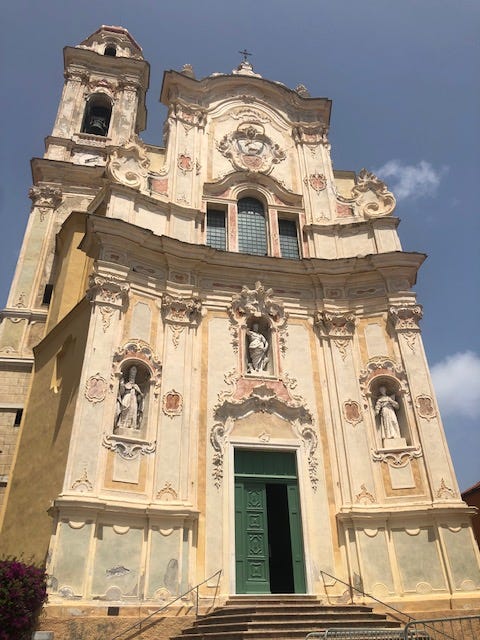
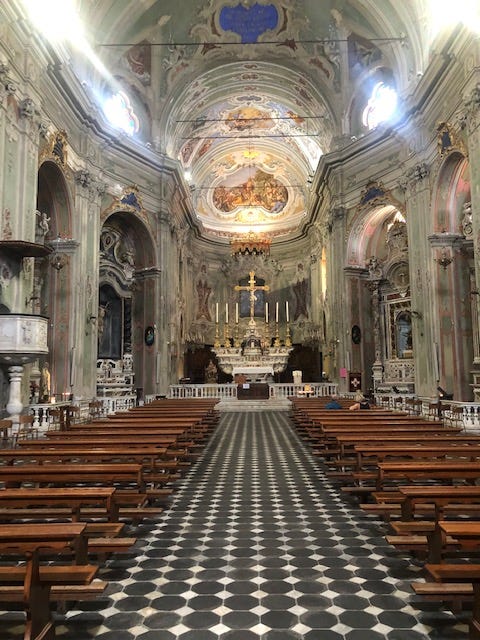
In 1686, architect Gio Bata Marvaldi started the construction of the Chiesa di San Giovanni Battista in the baroque style. After his death, the project was completed in 1722 by his son Giacomo Filippo Marvaldi. A large wide staircase gives access from the church square. The overwhelming interior consists of a main altar, side altars and chapels.
Various works of art are on display, such as a crucifix by the sculptor Anton Maria Maragliano, best known for his wooden statues, and an impressive marble pulpit from 1500.
Want a stop for a nice cappuccino? At the café next to the church, a spectacular view overlooking the Mediterranean is included…
We walk further and visit the Oratorio di Santa Caterina.
The originally Romanesque building from the thirteenth century was owned by the Knights of the Maltese Order and the Republic of Genoa in the following centuries. Then it was used as a city parliament and the first parish of Cervo.
In 1762, in honour of Saint Catherine of Alexandria, it became an oratory of the same name. Beautiful anonymous frescoes are here to admire, and a pulpit painted in pastel dating from the sixteenth century.
Above the main entrance, we see a fresco depicting San Giorgio che uccide il drago, Saint George killing the dragon.

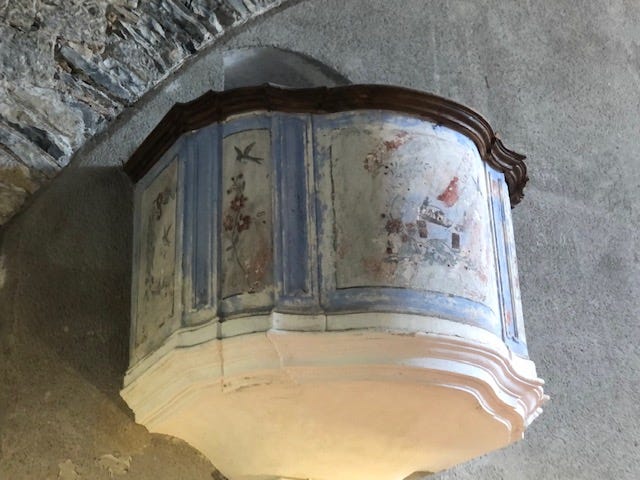
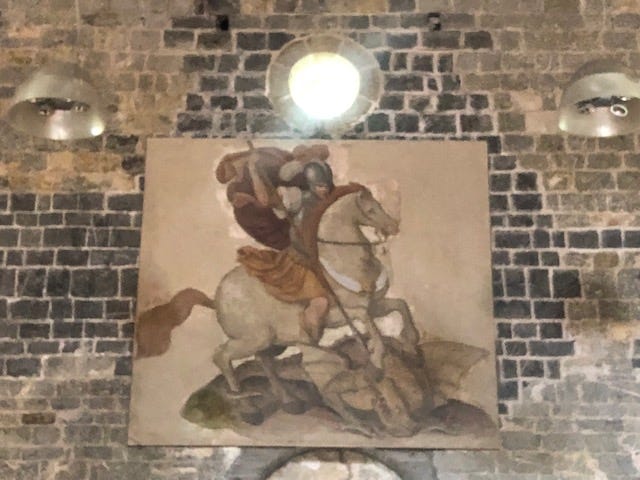
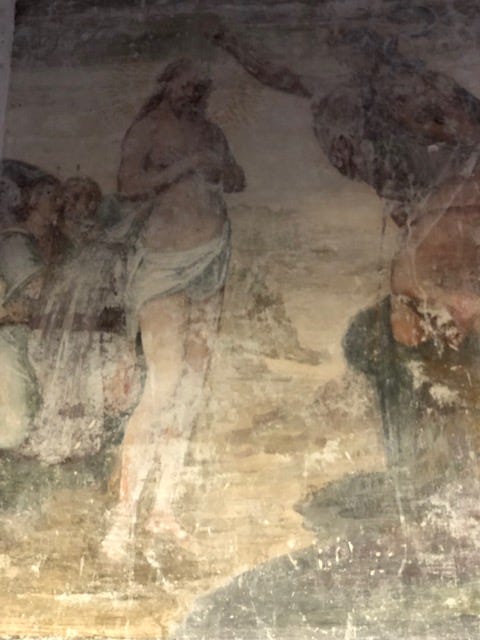
Nowadays exhibitions and concerts are organised here.
In the cultural field, a lot is also happening in Cervo in our time: music, literature and painting are important:
When Hungarian violinist Sandor Vegh came to Cervo in 1950, it started a tradition, the: Festival Internazionale di Musica da Camera, an annual international festival for chamber music. Since then, many famous musicians have participated, both in terms of jazz and classical music.
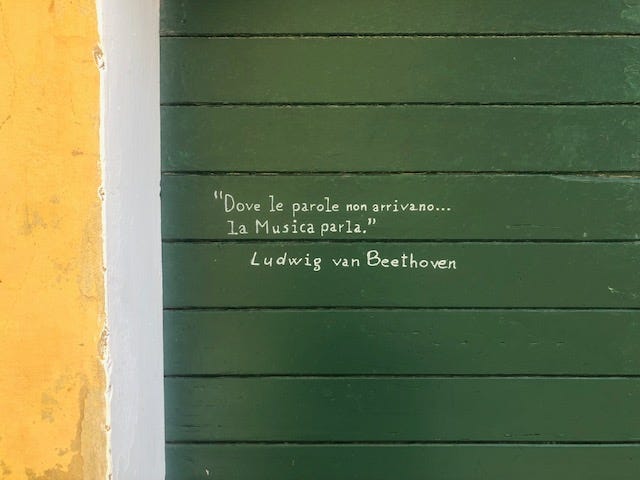
For literature lovers, there are Cervo in blu d'inchiostro, Cervo in ink blue, and Cervo ti Strega, Cervo enchants you, events in which participants of the Premio Strega, a prestigious literature prize awarded annually for the best fiction book written by an Italian author, read from their work and are presented.
Finally, Il Pennello d'Oro, The Golden Brush, is organised; mainly local artists' work is promoted here.
To end your visit, besides all the above, there are nice restaurants and terraces in Cervo with magical views per prendere l'aperitivo, to have a nice aperitif, or una cena all'aperto, a meal in the open air.
Alla prossima!
Source:
This newsletter is based on our own experiences and the extensive historical and cultural information provided by the website of the municipality of Cervo: https://comune.cervo.im.it/
Photos PW © 2020-2023.
Text Liguria Letters © 2020-2023





